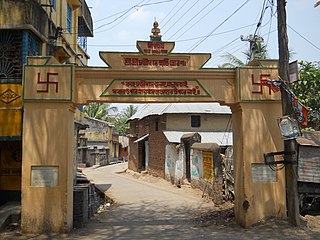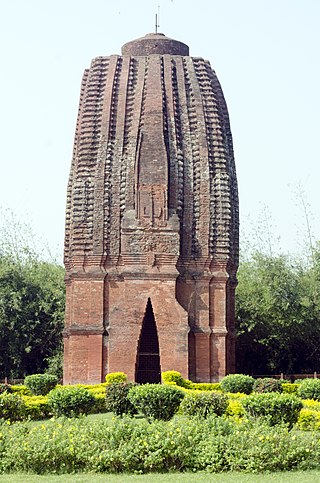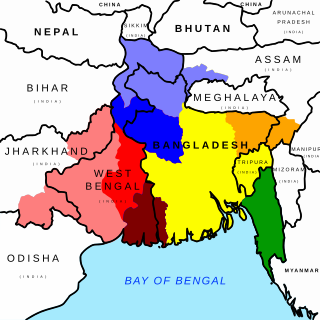
Kharar is a historical town of Ghatal and one of the oldest town in Asia. This city is located in the Ghatal Subdivision of the Indian state of West Bengal. Earlier this town was part of Hooghly District later it was merged with Medinipur district.

Nanoor, is a village in Nanoor CD block in Bolpur subdivision of Birbhum district in West Bengal. Nanoor is the birthplace of 14th century lyric poet Chandidas of Vaishnava Padavali fame. It is developing as a craft centre with NGO support. With the massacres in 2000, Nanoor was in intense media focus.
Ilambazar is a census town, with a police station, in Ilambazar CD block in Bolpur subdivision of Birbhum district in the Indian state of West Bengal.

Bahulara Ancient Temple is located in Bahulara village in the Onda II village panchayat, in the Onda CD block in the Bankura Sadar subdivision of the Bankura district in the Indian state of West Bengal. It is 5 km (3.1 mi) from Ondagram railway station and 25 km (16 mi) from Bishnupur.
Daspur is a village, with a police station, in Daspur I CD Block in Ghatal subdivision of Paschim Medinipur district in the state of West Bengal, India. Previously a part of Hooghly District, later in 1872 it was merged with Medinipur district.
Para is a village, with a police station, in the Para CD block in the Raghunathpur subdivision of the Purulia district in West Bengal, India.

Baidyapur is a village in Kalna II CD block in Kalna subdivision of Purba Bardhaman district, West Bengal, India.

Narajole is a village and gram panchayat in Daspur I CD Block in Ghatal subdivision of Paschim Medinipur district in the state of West Bengal, India.

Gourangapur is a village in Kanksa CD block in Durgapur subdivision of Paschim Bardhaman district in the Indian state of West Bengal. The place has links with Ichhai Ghosh, king of Gopbhum, and it is believed that his capital, Dhekur, was located nearby. The area was earlier a part of Senpahari pargana.

Supur is a village under Raipur-Supur gram panchayat in Bolpur Sriniketan CD block in Bolpur subdivision of Birbhum district, West Bengal, India.

Jatar Deul is located in district South 24 Parganas of the Indian state West Bengal. This is a brick temple and is datable between the 10th and 11th century on the basis of its architecture. However, this type of brick temple we can see at Nebia Khera, Uttar Pradesh.
Deulghata, near Baram in the Arsha in the Purulia Sadar subdivision of the Purulia district of West Bengal, India, has ancient/ medieval temples.

Sat Deul is a 10th-11th century temple at Deule / Sat Deule in the Memari I CD block in the Bardhaman Sadar South subdivision of the Purba Bardhaman district in the Indian state of West Bengal.
Ambikanagar is a village and a gram panchayat in the Ranibandh CD block in the Khatra subdivision of the Bankura district in the state of West Bengal, India.
Pathra is a village and a gram panchayat in the Midnapore Sadar CD block in the Medinipur Sadar subdivision of the Paschim Medinipur district in the state of West Bengal, India.
The Parvatinatha Temple is a saptadasa-ratna (seventeen-pinnacled) temple, built in the 19th century at Chandrakona in Ghatal subdivision of Paschim Medinipur district in West Bengal, India.
Karnagarh is a village and a gram panchayat in the Salboni CD block in the Medinipur Sadar subdivision of the Paschim Medinipur district in the state of West Bengal, India.

Bengal temple architecture is about temple styles developed and used in Bengal, particularly the chala, ratna and dalan temples.
Loyada is a village in the Debra CD block in the Kharagpur subdivision of the Paschim Medinipur district in the state of West Bengal, India.

Gopbhum or Gopbhumi is a historical region of West Bengal state in Eastern India. It included the area between the Ajay and Damodar rivers, which is present-day Purba Bardhaman, Paschim Bardhaman, and also some parts of Birbhum, and Bankura districts of West Bengal. English translation of the word 'Gopbhum' is 'The land of Gopa'.




















